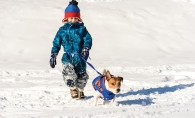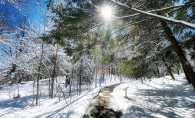Mike Kratochwill’s interest in kiteboarding—or kiting—began in childhood, long before he was ever exposed to the thrill of flying one. “I read a book when I was young about a kid that took off with a kite, and I remember it being just this grand adventure,” he reminisces. That fond memory stuck with him, and decades later, kiteboarding has allowed him the opportunity to turn his fictional fascination into a real-life pursuit.
Today, Kratochwill is the owner of the Lakes Area Kiting and Windsurfing Advisory. LAKAWA is a local, online organization where kiteboarders and windsurfers can congregate, check weather conditions, buy and sell gear, share news, and chat about the sport. Its revenue comes from the affiliated school, which is where Kratochwill himself picked up his skills nearly seven years ago.
Despite all his experience and enthusiasm, however, even he still struggles with finding the perfect descriptor for the sport. Without an ideal analogue, Kratochwill settles on something similar to a combination of parasailing and surfing/snowboarding. And though this model is not without its inaccuracies, it does emphasize the sport’s dichotomous nature quite well. “There are two major disciplines involved in the kiteboarding,” explains Kratochwill, “flying the kite and [navigating] whatever you’re using on your feet. You take those skills and couple them together, and that’s where it becomes a very unique experience.”
Another remarkable aspect of the sport is the fact that kiteboarding can be done year round, even here. “We’re incredibly fortunate to have this sport,” opines Kratochwill. “Some people don’t have the ability to do both kitesurfing and snowkiting unless they travel.” Here in Minnesota, all it takes for kiters to enjoy both the summer and winter seasons is a few simple gear substitutions.
When starting out, however, most will agree that beginning in the winter with snowkiting is the way to go. Because it lacks the complicating element of water, novices are able to feel and realize success much faster. Snowkiting 101, a one-day course offered through the LAKAWA school, serves as a great introduction to the sport. Class is hands-on and covers the basics, including kite launching, flying, riding and—perhaps most importantly—safety. The latter is something that Kratochwill puts great emphasis on, warning students that although long-time riders make the sport look graceful and effortless, beginners need to be cautious in their approach.
“There’s a little bit of a learning curve to it,” explains Kratochwill, “and kites are powerful. They’ll pull you off the ground, and they’ll pull you onto the ground, too. You can get hurt.” His warning is not meant to be one of discouragement, but rather encouragement to seek out the proper instruction before getting started. “Keeping up that level of awareness and education helps minimize what we call a ‘kite-mare,’” he quips.
One of the easiest ways to do this is to ensure that you’re using the appropriate type of kite. Kratochwill advises starting out on smaller, 2-3 meter “training” kites initially. These are typically less powerful, lighter weight and allow beginners to strengthen their piloting skills before moving on to larger, more unruly rigs.
Next to consider, is the type of kiting you want to be doing, as kites used during the summer months are structurally different from their winter counterparts. Summer kitesurfing rigs are partially inflatable, which creates a rigid skeleton that helps them stay afloat and aids significantly in the ease of re-launching the kite in open water. This modification is unnecessary during the frozen winter months, however, and the “foil” kites used in snowkiting secondarily more closely resemble a basic parachute.
After determining the type of kite you need, your weight is probably the most essential element to consider. “You really have to tailor the size of the kite to the person that’s using it,” says Kratochwill. “I have 11-year-old twins—they’re about 65 or 70 pounds—and there’s no way I’d put them on a 14-meter kite; they’d go across the state. I, on the other hand, weigh down that kite pretty well.”
Once the fundamental decisions have been made, you can move onto other, less crucial considerations, like style, appearance and cost. Though these decisions are based primarily on personal preference, Kratochwill is more than happy to be a resource in this process as well. “It takes a little bit of help from people to find the right stuff,” he explains, “I’d rather you’d get into something that’s safe and that you’re going to enjoy than [have you be] the person that gets really excited about kiting, buys the gear, has a bad experience, sells it, and never does the sport again.”
This benevolent attitude is one of the many reasons that the kiteboarding community continues to grow and thrive. “Everyone in the community is really helpful,” says Kratochwill. “The interaction is almost [inherent], because the wind doesn’t always blow, so you end up having some conversation time on the ground.” And LAKAWA does an excellent job of furthering this affinity by playing an active role in the organization and promotion of group kiting excursions, including their biannual trip to South Padre Island and past events like the Snow Kite Expo at Boulder Lake (near Duluth) and Kiteboarding for Cancer in Regina, Canada.
Community response to these efforts has been overwhelmingly positive, with substantial website traffic and event participation. Despite this, the exact population of the local kiteboarding community remains unknown. “Anything I say would just be a total guess,” says Kratochwill, “but 500 kiters is one of the numbers I’ve heard thrown around. I guess I’m just perpetuating that, but it’s just so hard to tell.”
Anecdotally, the number is known to be fairly small compared to other sports, which allows kiteboarding to be primarily regulated by its participants. “There’s no licensing involved, so we’re essentially self-policing,” says Kratochwill. Kiting on Lake Calhoun, for instance, is banned during the summer months due to the many hazards on and around the lake that make it unsafe for both kiters and others out enjoying the area. “Calhoun is a beautiful little nook,” acknowledges Kratochwill, “everything’s fantastic, but it’s too small. The sport, even for experienced kiters, requires clean, uninterrupted wind, and we just can’t get it there.”
Luckily, Minnesota has no shortage of kite-friendly lakes, which more than satisfy the varying needs and wants of the diverse kiteboarding community. Great local kiteboarding lakes include White Bear, Medicine, Waconia, Centerville and Mille Lacs. In addition, Lake Superior offers 3-15 foot waves in the summer and miles of open shoreline—excellent for “ocean-style riding” and gravity-defying acrobatics. Lake Minnetonka’s “Kite Island,” on the other hand, caters to the slightly less adventurous, with moderately calm waters, easy access points during the winter and picturesque sunsets.
But more important than what lakes you frequent, what type of kiting you enjoy, or whether you’re in it for the relaxation or the adrenaline rush, it’s the reason that you go in the first place. “I’m just absolutely awed by the sport,” says Kratochwill, “It’s all play, it’s all about having fun and I decided it was something I could do.”
“And,” he confides with a smile, “everyone’s always telling me to go fly a kite anyway.”









